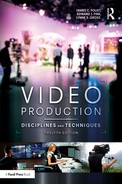Preface
This edition of the text has been revised and reorganized to reflect the many changes occurring in the dynamic field of video production. When the first edition of this book was published in 1978, television was dominated by three TV networks and some local stations. As the years have passed, the field has expanded to include cable and satellite TV, corporate video, Internet streaming, podcasting, and various other distribution technologies. Equipment, too, has changed, from analog-based to digital-based, while also getting smaller, cheaper, and, in most cases, more user-friendly.
Underlying Disciplines
Although the techniques and equipment of video may be changing, the disciplines that serve as the underlying strength of any operation remain much the same. The basic concepts of advance preparation, constant attention to detail, and teamwork assume a position of even more importance as technology progresses. Disciplines involve attitudes and behaviors such as teamwork, responsibility, self-control, initiative, and respect for the work of others. These disciplines are, in many ways, the most important part of any university-level production course. We believe that these disciplines are best learned within the structure of production exercises that involve full class participation and the rotation of students within the various crew positions.
Chapter Organization
Chapter 1 serves as an introduction to the material that follows in subsequent chapters. The chapter emphasizes the importance of disciplines and techniques, the role convergence plays in production, and the differences among studio, field, and remote truck production. It also acknowledges the changes in viewing patterns and devices brought about by digitization and fast data connections.
Chapter 2 provides an overview of the duties and responsibilities of cast and crew and will be useful as students begin production exercises.
Chapters 3 and 4 enable students to understand the crucial producing and directing functions early in the course. These chapters have been updated to reflect current practices and terminology. Already with the previous edition, we assumed that most readers are shooting in a high-definition, wide-screen (16:9) format, and tapeless, recording directly to solid state media, such as internal or external hard drives, SD cards, and the like. For this edition, Chapter 3, formerly “Producing,” has been reworked with a new title, “Producing and Scriptwriting,” and it has been reorganized with an expanded second half that covers the concepts and craft of scriptwriting in greater detail.
The specific equipment chapters—Chapters 5 through 11—cover cameras, lighting, audio, graphics and sets, the switcher, recording equipment, and editing equipment. The camera chapter now concentrates on high-definition ATSC formats, mentioning NTSC only tangentially. It acknowledges a wider range of camera types, including DSLRs and phone-based cameras, and it has expanded coverage of using them. It also discusses using drones for video production, as well as the rise of virtual reality technology. The discussion of lamps in the lighting chapter leads with a discussion of LEDs, as in the previous edition, because they are preferred for their energy efficiency and long life. While LED lamps outsell others, many practitioners continue to use quartz, fluorescent, and other instruments because they are part of a lighting director’s arsenal, so we continue to include a discussion of other lamps, as well. The audio chapter has been revised to emphasize current digital equipment.
In Chapter 8, more space is now devoted to how graphics are constructed, reflecting the growing importance of graphics in television; in addition, more emphasis is placed on types of sets for the 16:9 aspect ratio. The recording chapter has expanded and updated coverage of encoding and compression formats and techniques. The editing chapter features an expanded and updated discussion of editing preparation and of compression frames. It also no longer addresses capturing analog video, as we assume most schools are now shooting digital.
Chapter 12, on field production, features several updates throughout.
The book includes a glossary as a helpful reference for readers; it defines all of the book’s important terms, which are boldfaced on first use in each chapter within the text.
State-of-the-Art and Real-World Equipment
As in previous editions, we have covered equipment that in our view represents the technologies students work with in their institutions and will work with as they enter the job market. Some equipment used for illustration will be close to state of the art, but, in other cases, we have deliberately shown some older, proven units because they are typical of the technology in general use.
Web Material
Video Production is supplemented by an eResource www.routledge.com/9781138051812. There readers will find materials to supplement their studying and their work in the studio. Readers can view videos demonstrating production techniques. Forms provided throughout the book can be downloaded from the website. Focus-point and key-term reviews allow readers to go over the industry terminology and concepts they’ve learned, while web links give instant access to online material.
